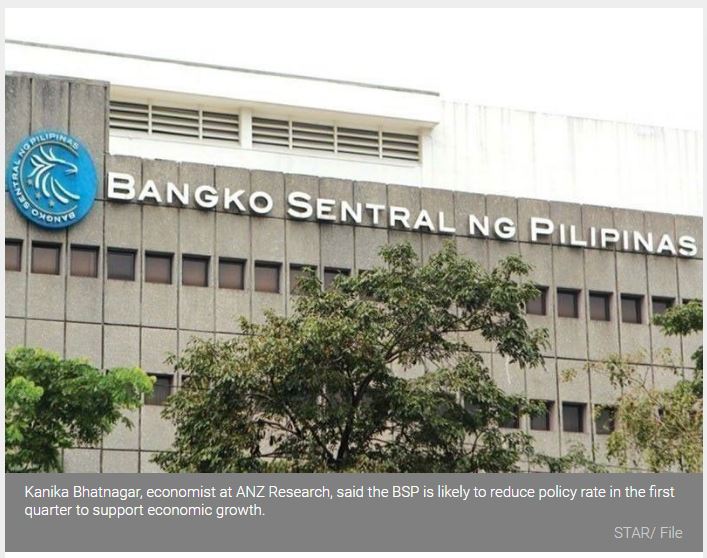Philippines: More BSP rate cuts expected
MANILA, Philippines — The Bangko Sentral ng Pilipinas (BSP) is expected to ease the country’s policy stance further after emerging as one of the most aggressive central banks in the world in the fight against the impact of the pandemic.
Kanika Bhatnagar, economist at ANZ Research, said the BSP is likely to reduce policy rate in the first quarter to support economic growth.
“We also expect the central bank to cut its policy rate by another 25 basis points in the first quarter in a bid to support the weak economic recovery, even though its efficacy is limited,” Bhatnagar said.
The BSP delivered a 200-basis-point rate cut last year, bringing the benchmark interest rate to an all-time low of two percent. It also slashed interest rate by 25 basis points in Nov. 19, 2020 and decided to keep the level steady on Dec. 17, 2020.
The Monetary Board has two rate-setting meetings in the first quarter scheduled on Feb. 11 and March 25.
ANZ said it expects the Philippine economy to bounce back with gross domestic product growth this year, but hinted real time indicators have been softening after a brief uptick in December on the back of the holiday season.
“The growth outlook for 2021 remains challenging. Mobility restrictions, albeit less restrictive than before, are still in place. The labor market is still weak, with the unemployment rate at 8.7 percent in the fourth quarter,” Bhatnagar said.
According to ANZ, fiscal spending this year would have to be effected more rigorously through the effective delivery of the P4.5 trillion 2021 national budget.
HSBC economist Noelan Arbis said the Philippine economy remains far from recovery, judging from the GDP figures in the fourth quarter.
“While sequential GDP growth appears robust at 5.6 percent quarter- on- quarter, the underlying data suggests that the economy remains sluggish. For one, private consumption did not improve much from the third quarter to the fourth quarter in seasonally-adjusted terms,” Arbis said.
According to the British banking giant, this suggests that households remained wary of spending amid ongoing movement restrictions and economic uncertainties despite a reduction of COVID-19 cases toward the end of 2020.
“Overall, the Philippine economy is on the path to recovery, but it remains far from reaching its pre-pandemic levels,” Arbis said.
HSBC expects the Philippines to recover with a GDP growth of 6.5 percent this year, but would remain below its 2019 levels by end-2021.
“Despite an expected pick-up in infrastructure spending, the absence of a big fiscal stimulus in addition to continued domestic and external uncertainties are likely to weigh on growth. The timeliness and effectiveness of vaccine distribution also remain in question,” Arbis said.
HSBC is not expecting the BSP to further slash interest rates this year but projects a 200-basis points reduction of the RRR in the second half depending on the demand for funds and the government’s fiscal impulse.
Meanwhile, the ASEAN+3 Macroeconomic Research Officer (AMRO) stressed the need for more efforts to enhance the effectiveness of monetary transmission and supporting credit expansion.
“Monetary and regulatory policy responses have been swift and effective in easing monetary conditions and ensuring ample liquidity in the financial system,” AMRO said.
The think tank explained the BSP should collaborate with other government agencies to offer banks greater incentives to increase lending to the business sector, especially micro, small and medium enterprises (MSMEs).
It added the development of financial risks should be closely monitored, while the intervention and resolution framework should continue to be strengthened.
AMRO is expecting a rebound with a GDP growth of 7.4 percent this year and 7.8 percent next year as long as the government maintains sufficient policy support to ensure a robust economic recovery while safeguarding against potential macroeconomic and financial risks.
Source: https://www.philstar.com/business/2021/02/01/2074373/more-bsp-rate-cuts-expected


 Thailand
Thailand




